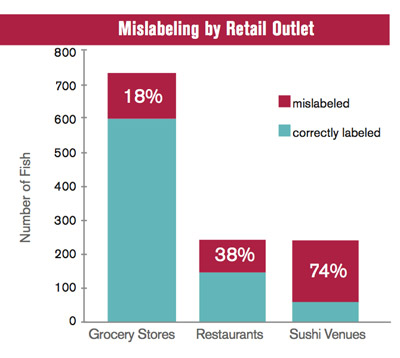In an earlier post we discussed the findings of a study done by Oceana.org regarding the rampant mislabeling of seafood. They found that about 39% of the seafood products that they sampled were actually a different species than what was represented on the label. Is this a big deal? Yes, it is, for many reasons. But what is more interesting, as one digs through the data, is where this disparity is occurring.
Sushi venues seem to be the largest culprits in terms of misrepresenting the food they are delivering. What is more disturbing is that not only are restaurants not serving the particular fish that they purport to, but that the degree of mislabeling at restaurants is so incredibly huge, that it seems almost impossible. The basic bullet points of the study are the following:
- 58 percent of the 81 retail outlets sampled sold mislabeled fish (three in five).
- Small markets had significantly higher fraud (40 percent) than national chain grocery stores (12
percent). - 100 percent of the 16 sushi bars tested sold mislabeled fish.
- Tilefish, on the FDA’s do-not-eat list because of its high mercury content, was substituted for red
snapper and halibut in a small market. - 94 percent of the “white tuna” was not tuna at all, but escolar, a snake mackerel that has a toxin
with purgative effects for people who eat more than a small amount of the fish. - Thirteen different types of fish were sold as “red snapper,” including tilapia, white bass, goldbanded jobfish, tilefish, porgy/seabream, ocean perch and other less valuable snappers.
But more significantly, the following chart illustrates just how much more likely you are to be the victim of this fraud at a sushi restaurant than a regular restaurant or grocery store.

Yes, a whopping 74% of the sushi tested from sushi restaurants was mislabeled, a huge number compared to the 18% in grocery stores, and 38% in regular seafood restaurants. Tuna, red snapper and salmon seemed to be the worst of the lot, and tuna is one of the most popular item on the menu. But with 94% of the tuna samples being mislabeled, you have to wonder how sushi restaurants can get away with this behavior. But get away with it they do.
Do with this knowledge what you will, but I am (and always have been) the annoying guy who asks a lot of questions about the sushi items I order. After reading this (for your convenience, I have a copy of the final report here if you are interested in reading it) I am sure that many of you may also start asking more questions about your order. If you don’t get what you par for, you should have a problem with that establishment.
I have always been fascinated by the creation and culture of different foods, particularly sushi and sashimi in the modern era of Japanese cuisine. I am a classically trained chef and sushi connoisseur, also having operated a food service company and enjoy investigating and experimenting with food around the world.
